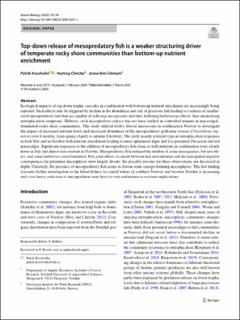| dc.contributor.author | Kraufvelin, Patrik | |
| dc.contributor.author | Christie, Hartvig C | |
| dc.contributor.author | Gitmark, Janne Kim | |
| dc.date.accessioned | 2020-09-22T12:30:15Z | |
| dc.date.available | 2020-09-22T12:30:15Z | |
| dc.date.created | 2020-09-04T15:16:09Z | |
| dc.date.issued | 2020 | |
| dc.identifier.citation | Marine Biology. 2020, 167 (4), 49. | en_US |
| dc.identifier.issn | 0025-3162 | |
| dc.identifier.uri | https://hdl.handle.net/11250/2679058 | |
| dc.description.abstract | Ecological impacts of top-down trophic cascades in combination with bottom-up nutrient enrichment are increasingly being reported. Such effects may be triggered by decline in the abundance and size of piscivore fish leading to a release of smaller-sized mesopredatory fish that are capable of reducing mesograzers and their buffering herbivorous effects, thus intensifying eutrophication symptoms. Hitherto, such mesopredator release has not been studied in controlled manner in macroalgal-dominated rocky shore communities. This study utilised twelve littoral mesocosms in southeastern Norway to investigate the impact of increased nutrient levels and increased abundance of the mesopredatory goldsinny wrasse (Ctenolabrus rupestris) over 6 months, from spring (April) to autumn (October). The study mainly revealed typical eutrophication responses in both July and in October with nutrient enrichment leading to more ephemeral algae and less perennial Fucacean and red macroalgae. Significant responses to the addition of mesopredatory fish alone or with nutrients in combination were clearly fewer in July and almost non-existent in October. Mesopredatory fish reduced the number of some mesograzers, but not others, and some herbivores even benefitted. Few joint effects occurred between fish and nutrients and the anticipated negative consequences for perennial macrophytes were largely absent; the possible reasons for these observations are discussed in depth. Curiously, the presence of mesopredatory fish seems to favour some canopy-forming macrophytes. This last finding warrants further investigation as the labrid fishery in coastal waters of southern Norway and western Sweden is increasing and a too heavy reduction of mesopredators may have its own unforeseen ecosystem implications. | en_US |
| dc.language.iso | eng | en_US |
| dc.publisher | Springer | en_US |
| dc.rights | Navngivelse 4.0 Internasjonal | * |
| dc.rights.uri | http://creativecommons.org/licenses/by/4.0/deed.no | * |
| dc.title | Top-down release of mesopredatory fish is a weaker structuring driver of temperate rocky shore communities than bottom-up nutrient enrichment | en_US |
| dc.type | Peer reviewed | en_US |
| dc.type | Journal article | en_US |
| dc.description.version | publishedVersion | en_US |
| dc.source.pagenumber | 20 | en_US |
| dc.source.volume | 167 | en_US |
| dc.source.journal | Marine Biology | en_US |
| dc.source.issue | 4 | en_US |
| dc.identifier.doi | 10.1007/s00227-020-3665-3 | |
| dc.identifier.cristin | 1827456 | |
| cristin.ispublished | true | |
| cristin.fulltext | original | |
| cristin.qualitycode | 1 | |

